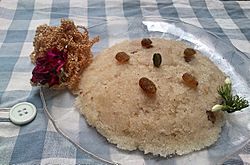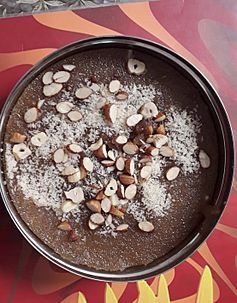Suji ka halwa facts for kids
 |
|
| Alternative names | Rawa sheera, sooji halwa |
|---|---|
| Type | Dessert |
| Region or state | India, Pakistan, Bangladesh |
| Main ingredients | semolina, sweetener, fat (butter, ghee or oil), milk (optional), fruits and nuts (optional) |
| Similar dishes | Sanwin makin |
Suji is a yummy sweet dish, a bit like a soft cake or pudding. It's made from a special kind of flour called semolina. To make it, semolina is cooked in butter or oil, then mixed with something sweet like sugar syrup or honey.
People often eat Suji for breakfast or as a tasty dessert. The basic recipe uses just semolina, sugar or honey, and a type of butter called ghee. Sometimes, milk is added too. You can also find many different kinds of Suji. Some have dried fruits, fresh fruits, nuts, or shredded coconut on top.
The Story of Suji: A Sweet History
Suji has a long and interesting history! People have been making sweet dishes like Suji for hundreds of years.
Ancient Recipes from Around the World
Long ago, around the 900s, people in Arabic countries made a similar sweet. They roasted milled wheat in butter. Then, they added honey or sugar syrup to make it moist and sweet. One old recipe, called hulwa a'jamiyya, used boiled honey syrup. It was often decorated with pistachios and poppyseeds. Sometimes, milk was added, along with toppings like almonds, pistachios, and pine nuts.
A cookbook from the 900s even had recipes for this dish made with carrots, apples, and dates! Some people think this sweet dish came to India from the Mughals. But it was already mentioned in an Indian book from the 1100s. This book, called Manasollasa, described a dish similar to today's Kesari bat.
In the 1300s, in Spain, a similar dish was made. Semolina was cooked with almond milk, oil, and sometimes saffron for color. In India, the dish called sheera is made with semolina, ghee, and sugar. People often add cardamom, milk, almonds, and cashew-nuts to it.
What Do We Call Suji?
Suji has many different names depending on where you are!
- In the Marathi language, it's called rawa sheera.
- If a similar sweet is made with wheat flour, it's called gavhacya pithaca sheera.
- In Hindi, it's known as sooji ka halwa.
- In South India, this dish is often called Kesari bat.
- In Myanmar (which used to be called Burma), the dish is known as sanwin makin.
- In the Caribbean, people of Indian heritage call it Mohan bhog or simply parsad. This is because it's a common sweet offered as prasad in pujas (Hindu religious ceremonies).
- In parts of Tulu Nadu, it's called Sajjige.


